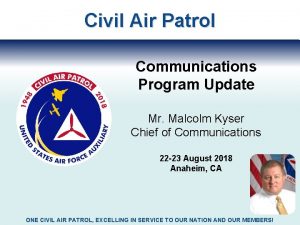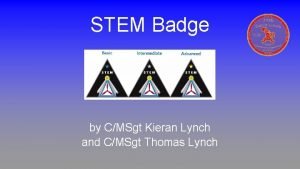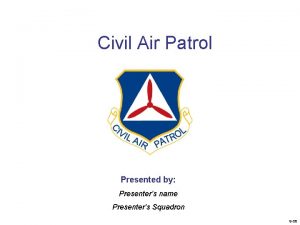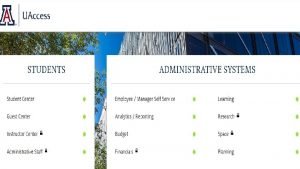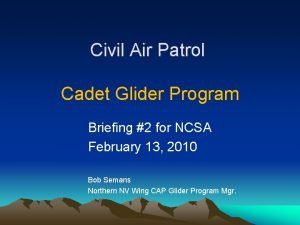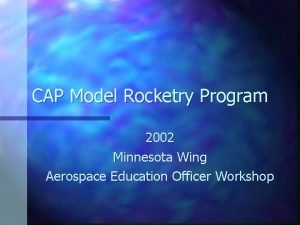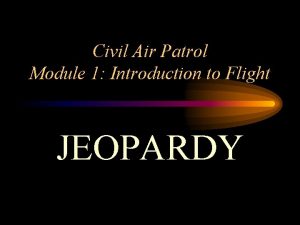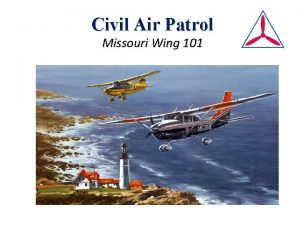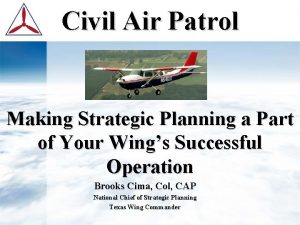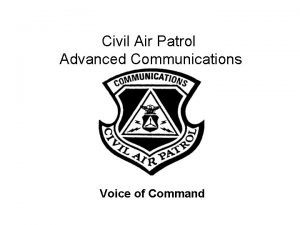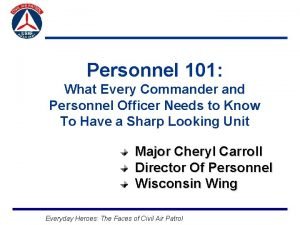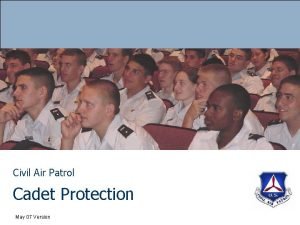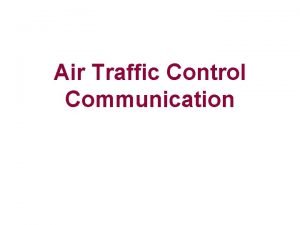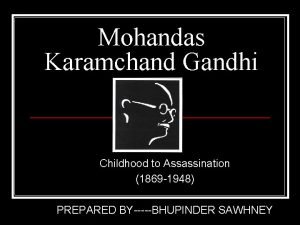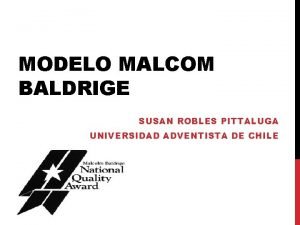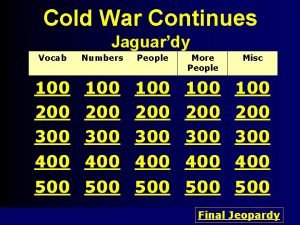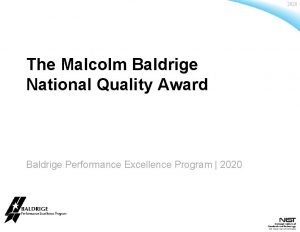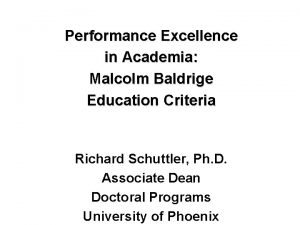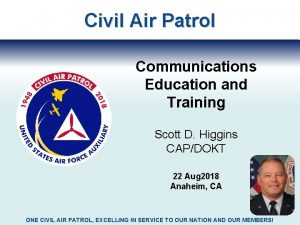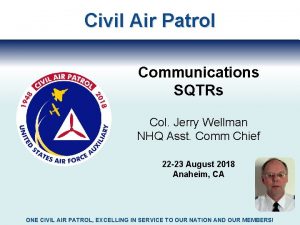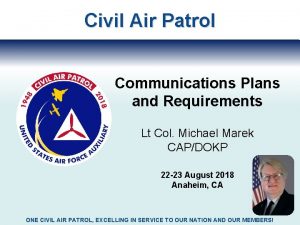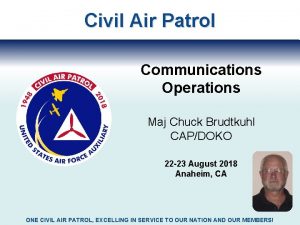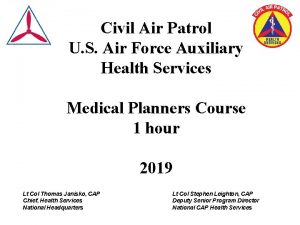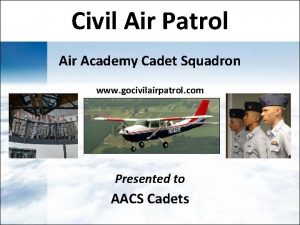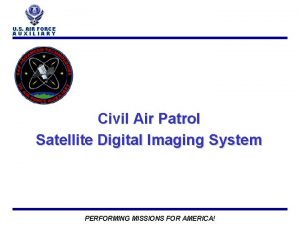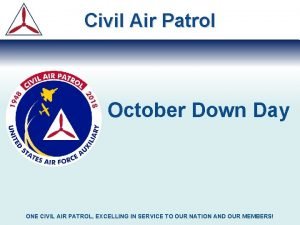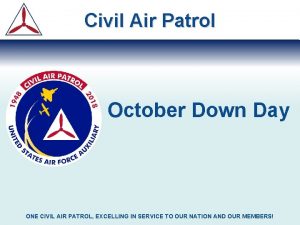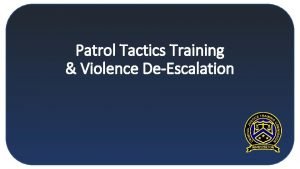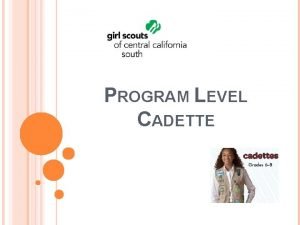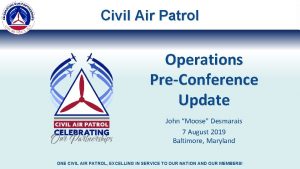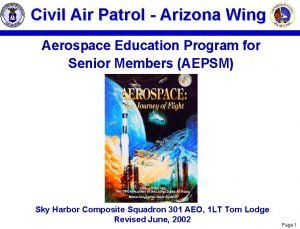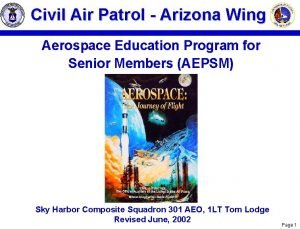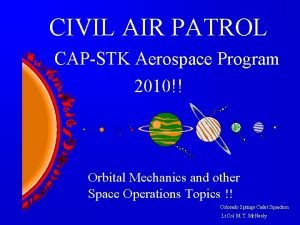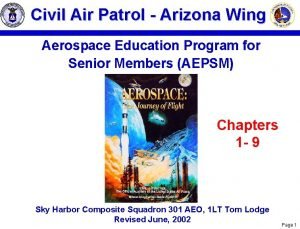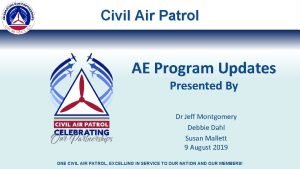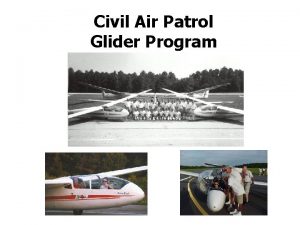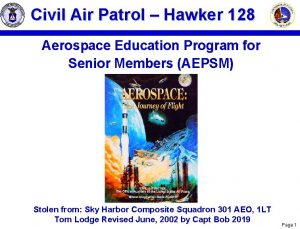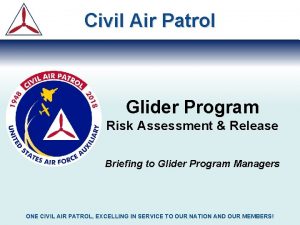Civil Air Patrol Communications Program Update Mr Malcolm


































- Slides: 34

Civil Air Patrol Communications Program Update Mr. Malcolm Kyser Chief of Communications 22 -23 August 2018 Anaheim, CA ONE CIVIL AIR PATROL, EXCELLING IN SERVICE TO OUR NATION AND OUR MEMBERS!

What’s New? Ø AF HF Study Ø Do. D mission Ø Table of Allowances (TA) Ø LMR Contract Ø Ready. Op Ø HF Data Ø LMR Transition

AF HF Study Ø Vice Chief of Staff of the Air Force (VCSAF) tasked Air University (AU) to: 1. Conduct a study into how the AF could rapidly gain HF C 3 capability and 2. Provide report in the form of an immediately actionable plan Ø AU/CC requested CAP provide an SME Ø Study conducted from Oct – Dec 17 Ø Final report signed by General Wilson, Mar 18 Ø CAP cited in recommendations

AF HF Study Ø Study recommends: Ø Ø Ø Ø Contract with Harris Corp for the wideband capable PRC-160 Set aside an initial $60 M for immediate procurement Install at every aircraft bed-down location world wide Install at all 13 Air Operations Centers Restore the HF radio operator career field Reopen the HF radio operator school Decentralize HFGCCS Ø AF staff at all levels currently working to implement plan

Do. D Mission Ø CJCS OPORD 2 -CY(S) Ø Ø CAP Command Team briefed, 19 July 18 New mission accepted Tasking signed by Gen Dunford, CJCS, on 27 July 18 We are now formally tasked Ø Disaster Relief (DR) Ø Aerial reconnaissance Ø Light transport Ø Communications

Do. D Mission Ø Implementation Ø AF Planning Ø NORTHCOM Ops Plan Ø AFNORTH Ops Plan Ø CAP Planning Ø Operations Ø Communications Ø Do. D Quarterly COMMEX Ø CAP now tasked to participate Ø Scenarios will increase in complexity Ø More flying

Federal HF Interops Ø CAP will restructure all federal HF interops Ø“Push” traffic movement methodology ØDuty of the national message center stations Ø Do. D ØIncoming: Do. D stations come to Triblade Net ØOutgoing: Triblade stations go to Do. D Net Ø MARS ØIncoming: MARS stations come to Triblade Net ØOutgoing: Triblade stations go to MARS Net Ø SHARES ØIncoming: SHARES stations come to Triblade Net ØOutgoing: Triblade stations go to SHARES Net

Budget Developments Ø CAP “Re-Baselining” Initiative Ø NHQ “Mother Of All working Groups” (MOAG) Ø A Challenge and an opportunity Ø Show new ideas, new technology, cost savings Ø Table of Allowances revision Ø Complete top to bottom study of requirements Ø Customer led Ø New equipment selections Ø New LMR contract Ø New HF data terminal Ø New internet remote LMR base station solution

Table of Allowances (TA) Ø Five year review Ø Jan – Mar, CAP/DO requirements study Ø Resulted in new draft Ø Apr - May, Draft validated by region DO’s, DOS’s, ICs from 2017 Hurricane Season, NESA staff Ø Jun – CAP Command Team briefed Ø Approved for coordination Ø July – Released to Comm Managers for comment Ø Sept – Target for coordination with CAP-USAF Ø Oct – Target for final approval

LMR Mobiles Ø Ø Ø New LMR contract Motorola APX 4500 New TA restricts to corporate vehicles only Reduces requirement from 2, 401 down to 1, 059 $1. 7 M savings $2, 235 each $1, 580 each

LMR Handhelds Ø New LMR contract Ø Motorola APX 4000 or SRX 2200 Ø Fewer ground teams reduces requirement from 2, 124 down to 1, 826 Ø Extended service life from 7 to 10 years Ø $750 K savings in cost of replacement $1, 765 each $1, 016 $2, 518

ISRs Ø Eliminated from TA Ø NHQ not planning to replace them Ø Ground team mission is changing Ø Ops believes non-ES needs are being met by other means Ø Tracking/loss has been a problem Ø Saves $670 K Ø Where needed, APX 4000 s are an option Ø But at about 10 x cost of ISRs

LMR Transition Plan Ø Full wing LMR replacement Ø Target: At least one wing per region per year Ø Prioritized by ops tempo Ø Once selected, NHQ and wing will validate requirements, plan the transition and determine disposition of legacy equipment before shipping begins Ø Migration will begin once: Ø Sufficient stock is assembled at NTC Ø User training is ready and published Ø NTC certification as Motorola service center is achieved Ø Target: First quarter of 2019

HF Base Stations Ø Refocus HF System Construction Ø Ø Build the infrastructure first Message Center Stations ICPs as primary “customers” Unit level delivery on hold -- for now

New HF Data Terminal Ø Was $6, 658 per terminal Ø Ruggedized laptop Ø Rockwell modem Ø Ø Now $3, 350 per terminal Rapid. M RM 2 modem Standard desktop for bases $5. 5 M cost reduction

New HF Data Terminal Ø Ruggedized laptop for RDPs. Desktop for base stations. Ø Customized terminal software for CAP’s needs Ø Configuration control Ø Implementation plan: Ø Ø This year: Triblades as testbed Next year: Region then wing MCSs Next: RDPs End goal: Every HF base station

Internet Remote Base Ø Internet remote base stations (Ready. Op) Ø LMR base station connected to an internet gateway Ø Allows operation of LMR systems at great distances Ø Repeater remote access Ø Repeater replacement

Internet Remote Base Ø Internet remote base stations (Ready. Op) Ø Will completely change our LMR system Ø Allows a complete “re-think” of LMR infrastructure Ø Possible elimination of half of our fixed repeaters over the next ten years

Remote Base Options Repe ater CAP Repeaters Rem ote A uard G AP CAP Aircraft C cces s Remote Base Station Incident Commander Internet Dismounted Ground Teams Ground Vehicles Incident Command Post

Ready. Op Dashboard

Internet Remote Base Fantastic advancement, however… Ø Uncertain availability in disaster response missions Ø Not allowed in support of the new Do. D mission Ø Therefore, Ready. Op cannot replace HF CAP position will be to take full advantage of both

Internet Remote Base Ø Planning considerations Ø Ø Not everyone will have access Only key staff members 1, 000 users nation-wide Wing will be allotted a certain number to manage

Internet Remote Base Ø Configuration control Ø Ø Ø Ø NTC packaged for a specific location Single dedicated channel Password protected Dashboard registered No microphone Disabled speaker Operating in mixed mode – analog transmit

Internet Remote Base Ø Expanded LMR coverage at a fraction of the cost Ø $708 instead of $19, 124 for a repeater Ø 95% cost reduction per station Ø Estimate 50% of repeaters replaced Ø $5. 2 M in savings

Implementation Planning Ø Remote bases incorporated into new TA Ø Requires wings to submit an “LMR Infrastructure Plan” Ø It’s time to “re-think” our LMR mission requirements Ø Guidance will be published Ø RARS will be reset for this new round Ø Ø Will be modified to support both repeaters and remote bases All existing repeaters will be marked “Legacy” New applications will be submitted IAW Wing Infrastructure Plan Region and NRCG approval Ø Just like we did in ‘ 04 -’ 05 Ø Will take several years to complete Ø Wings will get Ready. Op when finished

Rethinking LMR Ø Fixed Repeater or Remote Base? Ø Remote base stations are the preferred solution Ø Replace fixed repeaters with remote base stations wherever possible Ø Use fixed repeaters only where there is a mission based need which a remote base cannot address Ø Repeater requests must be based on operational mission needs – not administrative use Ø Every fixed repeater will have a Ready. Op gateway assigned Ø Consider use of airborne repeaters and mobile HF for support of ground teams instead of fixed repeaters

Hosting Requirements Ready. Op Fixed Base Requirements Ø Broadband internet access Ø Priority restoral status Ø Automatic emergency power Ø I. E. , Generally NOT members’ homes Ready. Op fixed bases will be single channel with no mic or speaker. It is a single purpose device and part of our LMR infrastructure.

Transportable Remote Bases Ø One will be assigned to each Mobile ICP (per TA) Ø As defined in the Comm TA Ø Will have full national codeplug Ø Multiple uses

Sum it up! Ø Ø Ø Ø Ø Reduce LMR Mobile cost Reduce LMR Hand-Held cost Reduce HF Base cost Reduce HF Mobiles cost Eliminate ISR Reduce HF Data Terminal cost Introduce Internet Remote LMR Reduce Repeater costs Overall Savings: $20 Million From $49. 6 M down to $29. 6 M Ø Result: Perpetual sustainment funding!

POM Impact In Millions of Dollars 35. 0 30. 0 34. 6 31. 5 29. 6 25. 0 20. 0 15. 0 10. 0 18. 2 20. 0 22. 0 5. 0 Old POM 0. 0 2025 2030 New POM

Annual Cost In Millions of Dollars 3. 00 2. 50 2. 83 2. 89 2. 94 3. 00 2. 00 1. 50 1. 00 0. 50 1. 02 0. 00 2019 2020 2021 2022 2023

Spend Plan FY 18 APX 4500 Base Stations APX 4500 Mobiles Micom 3 T Mobiles HF Data Terminals Ready. Op Contract Ready. Op Gateways 240 230 16 40 1 61 $ 1, 580 $ 379, 200 $ 1, 232 $ 283, 360 $ 7, 847 $ 125, 552 $ 3, 350 $ 134, 000 $ 35, 000 $ 708 $ 43, 188 $ 1, 000, 300 183 106 119 28 60 $ 2, 518 $ 460, 794 $ 1, 232 $ 130, 592 $ 1, 580 $ 188, 020 $ 708 $ 19, 824 $ 3, 350 $ 201, 000 $ 1, 000, 230 FY 19 SRX 2200 Portables APX 4500 Mobiles APX 4500 Base Stations Ready. Op Gateways HF Data Terminals

Spend Plan Fixed Equipment LMR Base Stations Fixed Repeaters Ready. Op Base Station HF Base Stations HF Data Terminal Unit Cost $ 1, 580 $ 19, 125 $ 708 $ 6, 146 $ 3, 350 Requirement Base-Line Calculations New TA Total Cost Requirement Life Annual Units Cycle Baseline per (years) Requirement Year 1, 191 $ 1, 881, 780 273 $ 5, 221, 125 545 $ 385, 860 761 $ 4, 677, 106 895 $ 2, 998, 250 10 15 10 10 10 $ 188, 178 119 $ 348, 075 18 $ 38, 586 55 $ 467, 711 76 $ 299, 825 90 Transportable Equipment Unit Cost LMR Mobiles $ 1, 232 LMR Portable Repeaters $ 18, 500 LMR Handhelds $ 2, 518 HF Rapid Deployment Package $ 11, 221 HF Mobiles $ 7, 847 Encryption Key Loader $ 3, 300 Intra Squad Radios (ISR) $ 85 1, 059 $ 1, 304, 688 134 $ 2, 479, 000 1, 826 $ 4, 597, 868 134 $ 1, 503, 614 530 $ 4, 158, 910 134 $ 442, 200 0 $ - 10 10 2020 POM Cycle 2020 2021 $ 191, 753 $ 78, 638 $ 476, 597 $ 611, 043 $ 195, 397 $ 80, 132 $ 485, 652 $ 622, 653 2022 2023 2024 $ 199, 109 $ 202, 892 $ 206, 747 $ 81, 655 $ 83, 206 $ 84, 787 $ 494, 880 $ 504, 283 $ 513, 864 $ 634, 484 $ 646, 539 $ 658, 823 $ 1, 358, 032 $ 1, 383, 835 $ 1, 410, 128 $1, 436, 920 $1, 464, 221 $ 130, 469 106 $ 247, 900 13 $ 459, 787 183 $ 150, 361 13 $ 415, 891 53 $ 44, 220 13 $ - 0 $ 132, 948 $ 252, 610 $ 468, 523 $ 153, 218 $ 423, 793 $ 45, 060 $ 1, 476, 152 $ 1, 504, 199 $ 1, 532, 779 $1, 561, 901 $1, 591, 578 $ 135, 474 $ 257, 410 $ 477, 425 $ 156, 129 $ 431, 845 $ 45, 916 $ 138, 048 $ 140, 671 $ 143, 343 $ 262, 300 $ 267, 284 $ 272, 363 $ 486, 496 $ 495, 739 $ 505, 158 $ 159, 096 $ 162, 119 $ 165, 199 $ 440, 050 $ 448, 411 $ 456, 931 $ 46, 789 $ 47, 678 $ 48, 584

Questions? Malcolm Kyser CAP/DOK mkyser@capnhq. gov or dok@capnhq. gov ONE CIVIL AIR PATROL, EXCELLING IN SERVICE TO OUR NATION AND OUR MEMBERS!
 Cap readyop
Cap readyop Capp 60-41
Capp 60-41 Civil air patrol national conference
Civil air patrol national conference Civil air patrol kahoot
Civil air patrol kahoot Civil air patrol glider
Civil air patrol glider Civil air patrol model rocketry badge
Civil air patrol model rocketry badge Civil air patrol aerospace module 1
Civil air patrol aerospace module 1 Civil air patrol missouri
Civil air patrol missouri Civil air patrol strategic plan
Civil air patrol strategic plan Capr 100-1
Capr 100-1 Civil air patrol powerpoint template
Civil air patrol powerpoint template Cap blues
Cap blues Capr 52-10
Capr 52-10 Immediate update and deferred update in dbms
Immediate update and deferred update in dbms Air higroskopis air kapiler dan air gravitasi
Air higroskopis air kapiler dan air gravitasi Civil rights and civil liberties webquest
Civil rights and civil liberties webquest Air traffic communication
Air traffic communication Program of civil disobedience movement
Program of civil disobedience movement Modelo baldrige
Modelo baldrige Mlk vs malcolm x
Mlk vs malcolm x Malcolm x
Malcolm x Malcolm x kindheit
Malcolm x kindheit Macbeth character key quotes
Macbeth character key quotes Thy bones are marrowless analysis
Thy bones are marrowless analysis Malcolm ross model
Malcolm ross model Malcolm baddock
Malcolm baddock David hume 1711 a 1776
David hume 1711 a 1776 Malcolm x
Malcolm x Mlk vs malcolm x venn diagram
Mlk vs malcolm x venn diagram Dr malcolm pinto
Dr malcolm pinto Malcolm baldrige award winners 2020
Malcolm baldrige award winners 2020 Malcolm x
Malcolm x Malcolm x
Malcolm x Malcolm baldrige criteria for performance excellence
Malcolm baldrige criteria for performance excellence Norman malcolm ontological argument
Norman malcolm ontological argument
